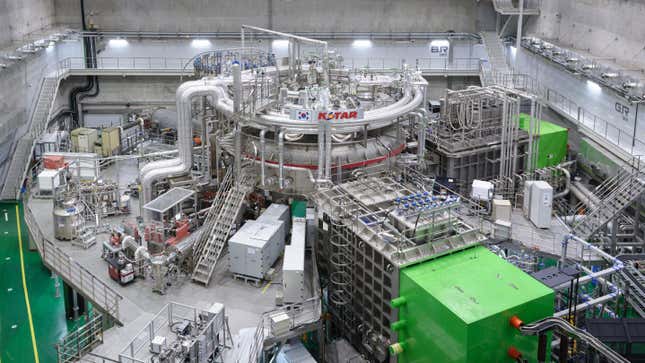The Korea Institute of Fusion Energy has installed a new diverter in the KSTAR tokamak, allowing the artificial sun to sustain high-ion temperatures exceeding 100 million degrees Celsius for longer.
KSTAR—called an artificial sun because it does nuclear fusion, the same reaction that powers our star—was completed in 2007 and achieved its first plasma in 2008. It is about one-third the size of ITER, the massive experimental reactor being built in France. Both reactors are tokamaks: doughnut-shaped devices that do nuclear fusion with plasmas, or electrically charged gases brought to super-high temperatures and pressures.
Advertisement
KSTAR uses a diverter, which sits at the bottom of the tokamak and manages waste gas exhaust and impurities from the reactor. The diverter is a plasma-facing component, meaning it sits within the tokamak and bears the full brunt of the internal surface heat. Currently, KSTAR is capable of plasma operations for about 30 seconds; scientists hope that the new diverter will allow plasma operations for 300-second periods by the end of 2026.
Advertisement

Advertisement
KSTAR originally had a carbon diverter, but in 2018 scientists began working on a tungsten diverter for the tokamak. Tungsten has a higher melting point than carbon and improves the heat flux limit of the reactor two-fold, according to a recent release from Korea’s National Research Council of Science and Technology. A prototype of the new diverter was completed in 2021, and installation was finished last year.
“In KSTAR, we have implemented a diverter with tungsten material which is also the choice made in ITER,” said KFE president Suk Jae Yoo in the release. “We will strive to contribute our best efforts in obtaining the necessary data for ITER through KSTAR experiments.”
Advertisement
Research into nuclear fusion has may slow but significant strides; in 2022, scientists at Lawrence Livermore National Laboratory managed net energy gain in a fusion reaction for the first time. We’re still very (read: very) far from the vaunted goal of a reliable, zero-carbon energy source, and the achievement came with caveats, but it nonetheless showed that the field is plodding forward.
ITER’s first plasma is expected in 2025, and first fusion is slated for 2035. But the reactor’s timelines have slipped while its costs have ballooned, from about €5 billion in 2006 to over €20 billion, according to Scientific American, so we may be waiting even longer than that.
Advertisement
Still, these are heady times for tokamak reactors. Last month, the six-story JT-60SA reactor in Japan was inaugurated; researchers affiliated with the project estimate it will take two years for the reactor to develop plasmas needed for experiments. There are more than 50 tokamaks operating around the world, according to the International Atomic Energy Agency.
Plasma experiments with KSTAR’s new tungsten diverter will continue through February, according to the National Research Council of Science and Technology, as the tokamak scientists make sure the environment is stable for experiments and that the 100-million-degree plasma can be reproduced in it.
Advertisement
More: Will Nuclear Fusion Ever Power the World?
Services Marketplace – Listings, Bookings & Reviews